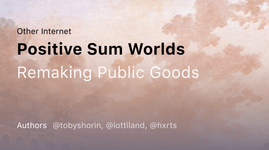
Saved by sari and
Positive Sum Worlds: Remaking Public Goods

Saved by sari and
Understanding public goods as positive externalities enables us to consider people that are not typically classified as members of a public to be our beneficiaries. This definition stands in contrast to economic discourse, where non-contributing users of some public good are considered "free riders," indicative of market failure. How could we
... See morewhile voting is symbolically powerful, this model misses an important truth: we do not discover shared values through individually revealed preference. If public goods are to satisfy shared values, then public discussion of what's of value matters!
When we think of the public, we should think expansively. This is not to say that we must consider everyone in the world as a part of our public. As we emphasized in our essay on squads, we also celebrate small, self-selective communities and trust-based groups. But by considering the effects (positive and negative) that we might have on groups at
... See moreWe want nothing less than entire communities aping into a redefinition of public concern. The opportunity in front of us is bigger than any one protocol. In today's world, capital is not scarce; ambitious visions for the public's benefit are.
Public goods are enacted by social institutions that reproduce patterns of behavior in the public interest.